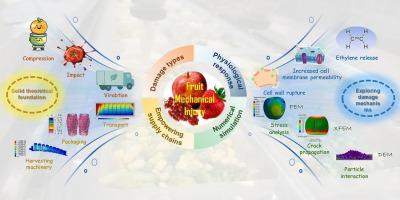Exploring fruit mechanical injury mechanisms: a review of numerical simulation techniques in the whole supply chain
IF 8.9
1区 农林科学
Q1 AGRICULTURE, MULTIDISCIPLINARY
引用次数: 0
Abstract
Mechanical injury is a key factor causing postharvest quality deterioration of fruits, significantly affecting their storage life and market competitiveness. Such injuries can occur during harvesting, packaging, processing, and transportation. A thorough understanding of the factors influencing fresh fruit damage is crucial for developing effective postharvest loss reduction strategies. Numerical simulation technologies, especially the finite element method (FEM), extended finite element method (XFEM), and discrete element method (DEM), provide powerful analytical tools for studying the response of fruits to compression, vibration, and impact under various mechanical loads and environmental conditions. Although these methods cannot directly prevent mechanical damage, they can offer scientific evidence and technical support for optimizing packaging structures, transportation methods, and harvesting mechanisms, thereby minimizing potential risks. This review systematically examines the formation mechanisms and physiological consequences of mechanical injuries in fruits, discusses the principles and latest application progress of mainstream numerical simulation methods, and focuses on key aspects of finite element analysis, such as model construction, material parameter setting, mesh generation, and boundary condition definition. It also explores the potential applications of simulation-driven design in various stages of the fruit supply chain. In the future, combining the physiological characteristics of fruits with artificial intelligence modeling may enable real-time decision-making and intelligent regulation of postharvest systems, promoting the development of fruit circulation toward high quality, low loss, and sustainability. By integrating fruit biomechanics and digital modeling, numerical simulations provide a solid theoretical foundation for minimizing fruit quality and value losses.

探索水果机械损伤机制:全供应链数值模拟技术综述
机械损伤是导致果实采后品质劣化的关键因素,严重影响果实的贮藏寿命和市场竞争力。这种伤害可能发生在收获、包装、加工和运输过程中。深入了解影响鲜果危害的因素对于制定有效的采后减损策略至关重要。数值模拟技术,特别是有限元法(FEM)、扩展有限元法(XFEM)和离散元法(DEM),为研究水果在各种机械载荷和环境条件下对压缩、振动和冲击的响应提供了强大的分析工具。虽然这些方法不能直接防止机械损伤,但可以为优化包装结构、运输方式和收获机制提供科学依据和技术支持,从而最大限度地降低潜在风险。本文系统介绍了水果机械损伤的形成机制和生理后果,讨论了主流数值模拟方法的原理和最新应用进展,重点介绍了有限元分析中模型构建、材料参数设置、网格生成和边界条件定义等关键问题。它还探讨了模拟驱动设计在水果供应链各个阶段的潜在应用。未来,将水果生理特性与人工智能建模相结合,可实现采后系统的实时决策和智能调控,推动水果流通向高品质、低损耗、可持续的方向发展。通过将水果生物力学和数字建模相结合,数值模拟为最大限度地减少水果质量和价值损失提供了坚实的理论基础。
本文章由计算机程序翻译,如有差异,请以英文原文为准。
求助全文
约1分钟内获得全文
求助全文
来源期刊

Computers and Electronics in Agriculture
工程技术-计算机:跨学科应用
CiteScore
15.30
自引率
14.50%
发文量
800
审稿时长
62 days
期刊介绍:
Computers and Electronics in Agriculture provides international coverage of advancements in computer hardware, software, electronic instrumentation, and control systems applied to agricultural challenges. Encompassing agronomy, horticulture, forestry, aquaculture, and animal farming, the journal publishes original papers, reviews, and applications notes. It explores the use of computers and electronics in plant or animal agricultural production, covering topics like agricultural soils, water, pests, controlled environments, and waste. The scope extends to on-farm post-harvest operations and relevant technologies, including artificial intelligence, sensors, machine vision, robotics, networking, and simulation modeling. Its companion journal, Smart Agricultural Technology, continues the focus on smart applications in production agriculture.
 求助内容:
求助内容: 应助结果提醒方式:
应助结果提醒方式:


